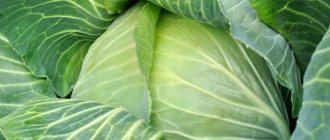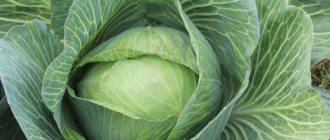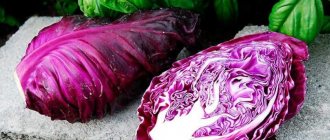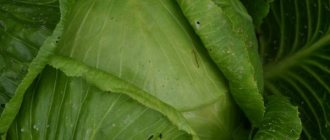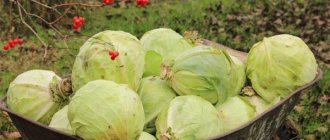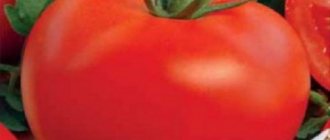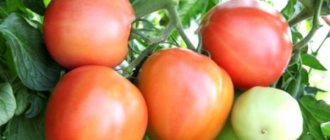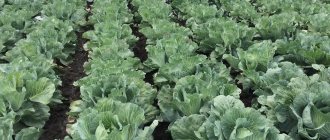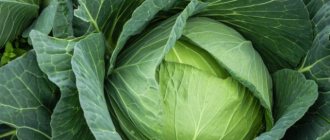Vestri F1 cabbage is a powerful hybrid that produces large forks of 4-8 kg. The vegetable is promising for cultivation in open beds and field conditions.
| Landing location | Ripening time | View | Purpose | Origin | Maturation period | Weight |
| Greenhouse, Open ground | Mid-season | White cabbage | Short-term storage, Cooking, Processing | Hybrid | 70-80 | 4-8 |
History of origin
The Vestry originated from wild species that were seen in Western Europe and Africa. It first appeared in Ancient Spain. Local residents called the hybrid “ashchi”. Since cabbage itself required serious care, people kept the secrets of growing it. Subsequently, Vestri spread to the territories of the Roman Empire, Greece and Egypt.
The second homeland of the hybrid is Russia . Our farmers, famous for their great hard work, were sensitive to its cultivation. Cabbage was a valuable everyday product that a common person could afford to consume.
An ancient reference manual of Kievan Rus (“Izbornik Svyatoslav”), which had a separate section, has survived to this day. It indicated the safety and methods of using the hybrid.
Features and description of late Moscow cabbage
The late Moscow cabbage variety, which is discussed in this material, was bred in 1937 by Soviet breeders. Workers at the All-Union Research Institute of Breeding used Pyshkinskaya cabbage as a base. The Moskovskaya late variety was included in the state register of achievements in 1943, and since then it has been grown throughout Russia.
According to the description, late Moscow cabbage has a number of important characteristics:
- a spreading leaf rosette that can exceed 1 m in diameter;
- oval wrinkled leaves of a gray-green color with a waxy coating;
- long petioles and rough veins on the leaves;
Cabbage is characterized by very large heads of cabbage.
- large and dense heads of cabbage, which have a flat-round shape and a white-yellow color;
- a high outer stalk, which reaches 30 cm, and a medium inner one;
- large mass of heads of cabbage, which reaches 5 kg - in favorable conditions it reaches 15 kg;
- high yield parameters - 900 centners of cabbage can be obtained from 1 hectare;
- high yield of commercial products;
- long shelf life.
This variety has two varieties, which differ in indices 9 and 15. They have certain differences.
Moscow cabbage late 9
This variety of white cabbage is characterized by a late ripening period - about 125-140 days. The plant also boasts dense flat-round heads weighing about 8 kg. Ripe cabbage has excellent taste and universal use.
Moscow cabbage late 15
This variety is characterized by an even later ripening period, which ranges from 142-160 days. The heads of cabbage have a flat-round or round shape. On average they weigh 5 kg, but sometimes the weight increases to 15 kg.
Cabbage has excellent taste and is characterized by universal use.
The plant is characterized by high productivity. Sometimes it is possible to harvest more than 1 ton of cabbage from 1 hectare. Vegetables tolerate transportation well, are stored well and do not crack.
Advantages and disadvantages
Advantages:
- resistant to diseases;
- large sizes;
- excellent taste;
- versatility in cooking;
- uniformity in shape;
- high yield.
Flaws:
- grows for a long time;
- short-term storage;
- poorly grown indoors;
- systematic loosening and watering is necessary.
Anyone planning to start growing cabbage may be interested in studying information about such varieties as Podarok, Centurion F1, Sugarloaf, Kolobok, Moskovskaya late, Valentina, Slava, Amager, Zimovka and Nozomi.
Adapter F1
Manufacturer S&G (Syngenta Seeds) Culture Cabbage Plant type White cabbage Direction Long-term storage, Processing Cultivation Open ground Ripening (seedlings) 110-120 days Head/head; color Grey-green Head/head; shape Round Head/head; weight 2.0-5.0 kg Storage 3-6 months Disease resistance Fusarium Country Holland Recommended density 35-40 thousand pieces/ha Year of registration 2009
DESCRIPTION
growing season 115-120 days head weight 3-4 kg round-shaped head hybrid with high growth vigor resistant to damage by thrips resistant to fusarium
Purpose
Fresh sales, processing and storage (up to 6 months)
Additional Information
Standing density is 30-40 thousand plants/ha. The hybrid tolerates a lack of nitrogen nutrition well. It is perfectly preserved in the field throughout the harvesting period. It has high commercial and taste qualities and meets all standards for pickling hybrids.
- Cabbage, variety Ankoma RC F1
- Cabbage, Hurricane F1 variety
- Cabbage, variety Etma RC F1
- Cabbage, variety Tobia F1
- Cabbage, variety Kilaton F1
- Cabbage, variety Magnus F1
- Cabbage, variety Vestri F1
- Cabbage, variety Kevin F1
- Cabbage, variety Atria F1
The page was found by the following queries:
- cabbage adapter
- 2114 G44ivX1tcCXztYQmejYXIf6p6txemN-l2YPVQhCmOatUMj_kZiojCpQ2mJvrMwdTuaI3HUnitZR_go20yRxWEj_ICbNkz1lf0GVGx6Ba_aA 03f04fbc8ad0926c2b52db6cb0ff 46180405d306
- 2114 gtIc8MjLHguuCSJZOJ4lYsakpNjJtbkHe1kN8R9006JEAUW3aNfx7RdGJMwitza4C5HgzJkfkMgw9tp6_u6JvA 1ef69c8b958ef535222b45e009fb7ce32262f36f
- cabbage adapter
- cabbage adapter description reviews
In stock: 10000 pcs.
High ductility and excellent quality. It is possible to obtain ideal heads of cabbage for the supermarket weighing 2–2.5 kg.
Standing density is 30–40 thousand plants/ha. The hybrid tolerates a lack of nitrogen nutrition well. It is perfectly preserved in the field throughout the entire harvesting period. With a planting density of 40 thousand plants/ha, you can get ideal heads of cabbage for the supermarket weighing 2–2.5 kg.
Manufacturer: Syngenta (Switzerland)
Ripening (early ripening): Mid-late
Vegetative period, days: 115–120
Purpose: Fresh sale, processing and storage for up to 6 months.
Fetal weight: 3.0-4.0 kg
Fruit shape: rounded head
Seeding rate, ha: 30-40 thousand.
Fruit color: gray-green with a waxy coating of intensity to strong
Flesh color: Whitish when cut
Name of variety (hybrid): Adapter F1
Resistance: resistant to thrips damage, resistant to fusarium
Storage: up to 6 months
State Register of Breeding Achievements of the Russian Federation: The hybrid is included in the State Register for the Central (3) region. Recommended for fresh use and short-term storage. Medium late. The rosette of leaves is raised. The leaf is medium-sized, gray-green, with a waxy coating of medium intensity to strong, vesicular, slightly wavy along the edge. The head of cabbage is round-flat, covered, and whitish when cut. Outer and inner stumps of medium length. Head weight is 1.8-2.3 kg, density - 4.2 points. The taste is good. Marketable yield is 280-342 c/ha, at the level of the Gift standard. Maximum yield 600 c/ha (Moscow region). The yield of marketable products is 88%. Resistant to fusarium wilt
Plant: hybrid with high vigor. Medium-sized leaf, gray-green, with a waxy coating of medium intensity to strong, vesicular, slightly wavy along the edge. The head of cabbage is round-flat, covered, and whitish when cut. Outer and inner stumps of medium length
Code (according to the State Register): 9253077
Year of inclusion in the State Register: 2010
Regions of admission (State Register): NORTH-WESTERN, CENTRAL, CENTRAL-CHERNOZEM, NORTH-CAUCASIAN, LOWER VOLGA, FAR EASTERN
Link to the State Register: https://reestr.gossort.com/reestr/sort/9253077
Instructions for care and planting
Where and how much can you buy seeds?
Most often, cabbage seeds can be purchased in an online store , but there are exceptions. The price for them ranges from 15 to 40 rubles per 10 pieces.
A selection of stores in Moscow and St. Petersburg:
- Moscow, metro station Rokossovsky Boulevard, Otkrytoe sh., 14, building 2.
- Moscow, metro station Komsomolskaya, Rizhsky proezd, 3.
- Moscow, metro station VDNKh, st. 1st Ostankinskaya, 53 (Shopping center "Rapira", pavilion 26E).
- Moscow, metro station VDNKh, Prospekt Mira, 119, VDNH Park, pavilion 7, hall 2.
- Moscow, metro station Maryina Roshcha, 3rd proezd Maryina Roshcha, 40, building 1, room 11.
- Moscow, metro Timiryazevskaya, st. Yablochkova, 21.
- St. Petersburg, metro Ladozhskaya, Zanevsky pr., 65, building 2, TC "Platforma".
- St. Petersburg, metro station Pionerskaya, Kolomyazhsky pr., 15, building 2.
- St. Petersburg, metro station Moskovskaya, st. Altayskaya, 16.
When is the best time to root a young plant?
Since Vestri is a mid-season cabbage (the period from germination to technical maturity is 85 - 95 days), it should be planted as early as possible . The optimal time is early March.
Preparing seedlings
To begin with, it is best to grow cabbage in separate containers (use peat pots). Depending on the weather, determine the time for planting seedlings in open ground. Seedlings should be planted when they are already quite strong and developed. However, it will be better if you do this earlier, because the plant will have more time to get used to the new place.
Cabbage seedlings grow best in sunny greenhouses , since there is no sub-zero temperature at night. Thus, the seedlings grow healthy and prepared for growing in open ground.
Temperature and soil
Cabbage can withstand cold well, but loves warmth and light. The formed heads can withstand temperatures from -5 to -8°. Temperatures above +25° are considered fatal for Vestry. 15-18 C° is considered optimal.
This variety needs well-warmed and fertile soil with low acidity. The best predecessors are legumes, cucumbers and potatoes.
However, any crop that has received enough fertilizer will do. The seed depth is 1.5-2.5 cm. This is where cabbage seeds should be planted for optimal growth.
Vegetable care
Cabbage planted in open ground should be watered with warm water (18-23°). The root system of the hybrid may suffer from hypothermia. Vestri needs moisture constantly: especially after planting seedlings and after the head of cabbage begins to form. The plant should be watered several times a day. The main thing is not to overdo it. Otherwise, the vegetable will rot.
Important! Hilling up is required after rain or watering!
The process is carried out until the rosettes of the emerging leaves close. The procedure is carried out 2-3 times, it will allow the formation of additional roots.
How to choose white cabbage varieties
Sowing season is in full swing and summer residents have a lot to do. All the window sills are filled with various seedlings that are waiting in the wings. Not many gardeners can find a place to plant cabbage seedlings at home. How to be? You can sow cabbage in a greenhouse, or directly into the ground, but the most popular solution is to purchase ready-made seedlings.
To get a good cabbage harvest, it is important to choose the right variety.
We have already discussed How to choose and buy seedlings correctly; We found out 12 secrets of growing cabbage seedlings, and in the article Cabbage, we not only looked at all the important features of this popular crop, but also talked about how to grow cabbage without seedlings, by sowing its seeds directly into the ground or into a greenhouse.
Fertilizing before rooting in open ground
- First liquid feeding carried out one and a half weeks after picking seedlings:
- ammonium nitrate – 2.5 g;
superphosphate – 4 g;
- potassium chloride – 1 g.
- Second liquid feeding , carried out another week: ammonium nitrate - 3-4 g.
Dissolve in a liter of water. - Third liquid feedingwhich is carried out a few days before planting seedlings:
- potassium chloride – 2 g;
superphosphate – 8 g;
- ammonium nitrate – 3 g.
Dissolve all ingredients in a liter of water.
Also dissolve in a liter of water.
During the period of increasing volume, cabbage consumes a large amount of elements from the soil. Therefore, the hybrid needs systematic feeding. Vestries are excellent at absorbing organic matter. It is advisable to add manure for autumn plowing, and in spring it requires nitrogen, potassium and phosphorus. It is also advisable to place manure at a shallow depth.
The best varieties and hybrids of white cabbage
When choosing a variety of white cabbage, first of all, you need to pay attention to the indicated ripening periods, since its commercial properties depend on them - suitability for pickling or long-term storage. What to choose - a cabbage variety or a hybrid? You can focus on this factor: hybrids usually ripen together, and when using a variety, there is usually non-simultaneous ripening of heads of cabbage
Therefore, focus on how you plan to use the cabbages: the entire harvest at once or is it more convenient to gradually harvest the heads of cabbage?
What to choose - a cabbage variety or a hybrid? You can focus on this factor: hybrids usually ripen at the same time, but when using a variety, there is usually non-simultaneous ripening of heads of cabbage. Therefore, be guided by how you plan to use the cabbages: the entire harvest at once or, more conveniently, gradual collection of heads of cabbage.
According to early ripening, cabbage hybrids and varieties are divided into early, mid-ripening and late. Early varieties (from germination to harvesting 90-120 days) are used for culinary processing shortly after harvest, for salads.
Mid-season varieties (121-150 days) are suitable for both cooking and short-term storage, for pickling with quick consumption. Late varieties of cabbage (151-180 days) are intended for pickling and long-term fresh storage.
And now more details.
Early varieties and hybrids of white cabbage
Heads of early varieties are usually medium-sized (1.5-1.8 kg), loose, with succulent leaves. With abundant watering (rainy summers) they are prone to cracking. Varieties: Skorospelaya, Iyunskaya, Zarya MS, Number One Gribovsky 147, Tochka, Pharaoh.
Hybrids F1: Aurora, Adema P3, Admiral, Sparrow, Granddaughter, Cossack, Hermes, Malachite, Cambria, Craft, First Love, Parel, Solo, Start, Reactor, Surprise, Express., Dumas (one of the fastest ripening).
Varieties and hybrids of medium-ripening cabbage
Mid-early (121-126 days), head weight up to 2.3 kg. Varieties: Golden Hectare 1432, Stakhanovka 1513.
F1 hybrids: Amazon, Bronco, Eaton, Invento, Volley, Metalor, Castello, Rotunda, Perfecta, Fresco.
Mid-season (126-135 days), weighing up to 2.7 kg Varieties: Taininskaya, Slava 1305, Nadezhda, Belorusskaya 455. F1 hybrids: Cecil, Semko Yubileiny 217, Kqualitor, Zosya, Marcello, Krautman, Cook
Mid-season varieties are already suitable for pickling
Medium late (136-150 days), heads of cabbage 2.2-3.5 kg Varieties: Gift, Harvest, Rusinovka.
Hybrids F1: Adapter, Aggressor, Geneva, Leopold, Midor, Krautkaiser, Megaton, Pegasus, Reaction, Raznosol, Snowflake, Sirius, Satellite, Erdeno, Favorite, Hinova, Hurricane
Excellent reviews about the Aggressor cabbage variety (more precisely, it is not a variety, but an F1 hybrid), it is in the photo. Beautiful powerful leaves, quick ovary of heads, identical shaped heads weighing more than 3 kg.
Late varieties of white cabbage
Large heads of cabbage weigh up to 4 kg; with good care they can reach more than 10 kg. However, we want to warn you: for inexperienced summer residents, it is often impossible to grow late varieties of cabbage; often only leaves grow without forming a head of cabbage.
Varieties: Vyuga, Moscow late, Kamenna glova, Zimovka 1474, Sugarloaf, Kharkov winter. Hybrids F1: Upton, Aros, Albatross, Amtrak, Valentina, Garant, Galaxy, Zastolny, Dominant, Kolobok, Kalorama, Counter, Krymont, Lezhkiy, Lennox, Monarch, Novator, Ramko, Ulyana, Extra, Anniversary, Favorite.
Harvesting
Since the period from sunrise to technical maturity is 85-95 days, harvesting should be done in July and August. Harvesting cabbage is not at all difficult; The main thing is to know some features, the observance of which will preserve the quality of the vegetable. All you need is a sharp knife or spatula (in case you want to dig up the cabbage along with the root).
- Lightly cut off the head of cabbage, leaving the lower leaves and the fertile stem (3 to 5 cm long).
- Do not place cabbages on the ground. It is better to place them on a covered soil or container.
- If you want to preserve the cabbage, keep the cut heads in the garden. The top leaves should wilt.
- When digging a hybrid from the soil, thoroughly clean the root system from the soil and tear off the yellowed leaves.
- Also dry the cabbage with roots on the covered soil.
Important! Do not forget to dig up the remaining roots and root stalks so that various diseases cannot develop in them.
A properly harvested crop will be stored throughout the fall and early winter. Vestri quickly deteriorates when fresh (about 3-4 months), so most often the majority of heads of cabbage are used for pickling. In this case, the vegetable does not lose vitamins and nutrients. If you are more interested in cabbage varieties suitable for long-term fresh storage, read a separate article.
Description of the variety
Vestri is a hybrid variety of white cabbage with a mid-early ripening period. Heads of cabbage reach technical ripeness 85–100 days after planting the seedlings.
This is a fairly powerful, strong plant, the head of which can grow up to 4–8 kg. Cabbage has large, medium-sized, slightly bubbly leaves, collected in a large, raised rosette. The leaves have a pleasant green color and a smooth, waxy surface. The heads of cabbage are round-flat in shape, uniform, dense, with a short inner stalk.
It should be noted that the yield of commercial products is over 95%
The hybrid is characterized by high yields. In one season, 500–750 centners of fruit can be collected from 1 hectare. The maximum yields were recorded in the Smolensk region and amounted to 870 c / 1 ha. Vestri fruits are universal, excellent for fresh consumption, as well as for canning, processing and storing for the winter.
